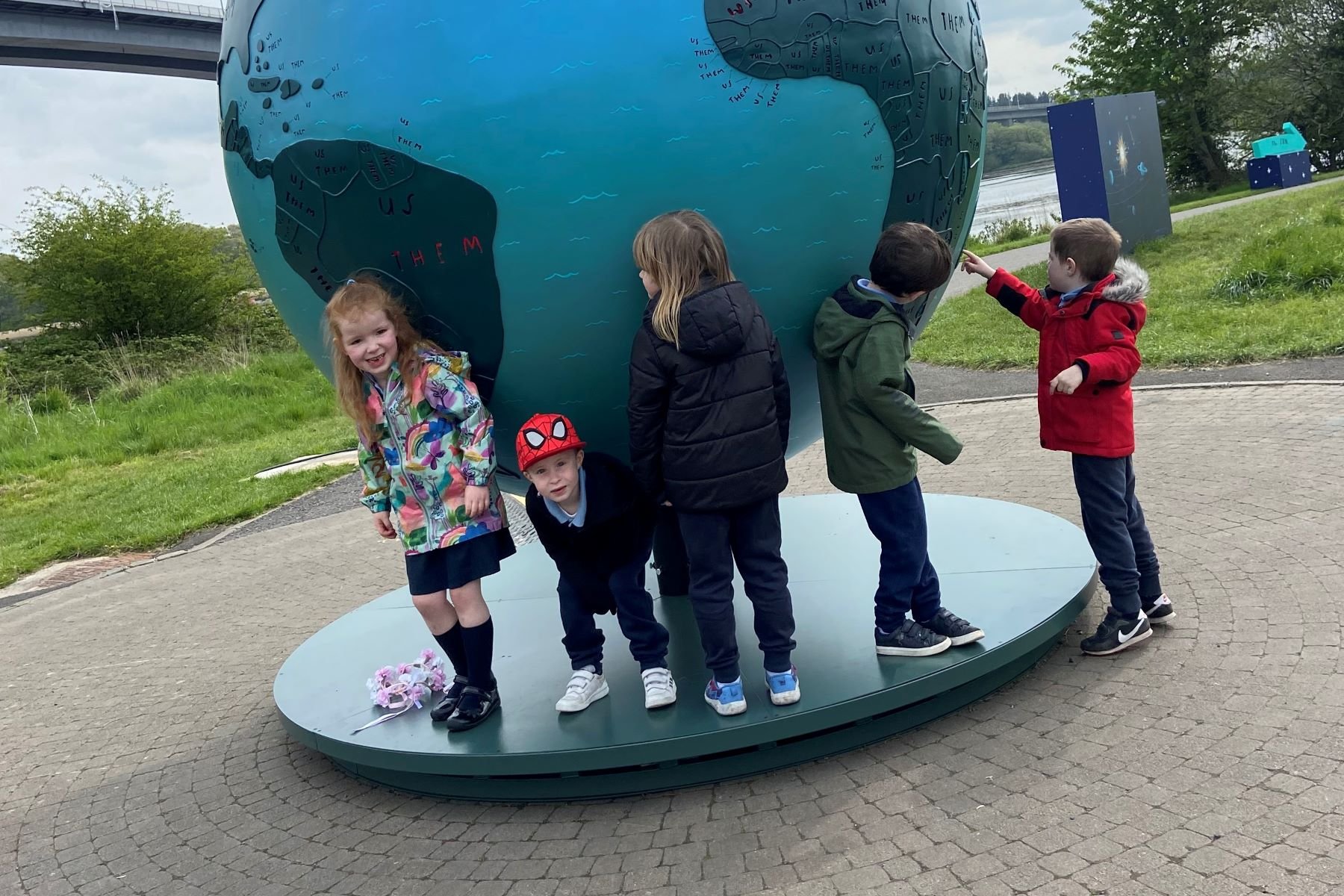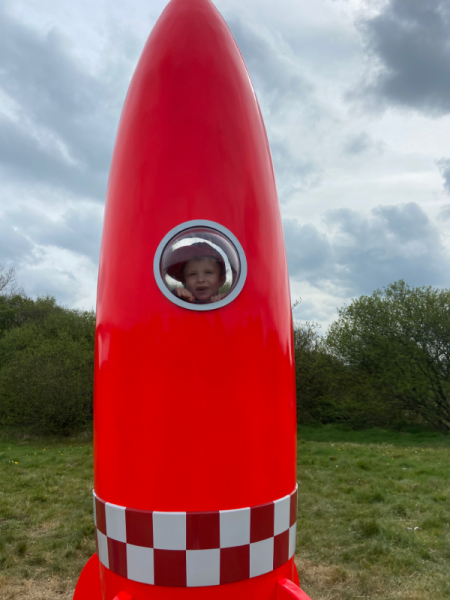
Above and below right: Children visiting Our Place in Space project
Photo: Dan Byrne
We’re all astronauts, but some of us need more space
Cultural experiences – as offered by Our Place in Space – are vital for youngsters with special educational needs. Dan Byrne, an SEN teacher, suggests more can be done to make them accessible and fulfilling.
Recently, I took two classes on a train journey from Derry to Belfast. For most, such a trip might be ordinary or a tad mundane – perhaps a chance to stare out of the window or catch up on some sleep.
But for me, the journey was an example (in a career overflowing with them) of how massive these experiences can be for people who don’t usually get offered this kind of opportunity. It was particularly true for this group of 17–19-year-old SEN students, some of whom had never been on a train before, or outside Derry at all.
Their excitement was wonderful. When one of them needed the loo and I explained there was a toilet on the train, the reaction – “There’s a TOILET on the TRAIN?!” – was what mine might have been had I been politely informed by the conductor that the train was about to submerge underwater and transform into a submarine.
When we got to Belfast and walked around the busy, bustling city, my students were like explorers discovering a new world, marvelling at the size of things and pointing out the unfamiliar sights. One said: “This is like another planet!"
Creating memories
Such events can turn into memories that greatly enhance a young person’s confidence and a sense of place in the world. I’ll often meet a former student who reminds me excitedly of a trip or activity we experienced together years ago. What I had completely forgotten, had become, to them, a cherished memory. These memories couldn’t have been created staying in the classroom.
That’s why I’m always eager to involve students in new activities and take them to new places. Seeing pictures from these trips also affects their parents: cumulatively, it gives them confidence to take their kids to different places and be more ambitious.
When arranging these trips, we need full confidence that our young people will be able to access them meaningfully and to retain their comfort and personal privacy throughout – such as at times when medication or a nasogastric feed are required. Sadly, this isn’t always the case, particularly when access provision is ambiguous or an afterthought on the part of event organisers.
I remember a sculpture exhibition on Donegal beach featuring a large whale. The students were excited about seeing it, but there wasn’t a walkway provided so the kids who were wheelchair users had no way of getting up close. Because of these experiences, I’m particularly enthusiastic when I encounter a project that embraces the practices and provisions I’d love to see as standard across the sector.
Guides were crucial to student engagement
 A recent example is Our Place in Space. Part of UNBOXED: Creativity in the UK, it is a sculpture trail combining art and science that recreates the solar system along a 10km pathway beside the river Foyle. Such a large, visible public installation had been the subject of much conversation among us teachers during its construction. Free of charge, it’s a great opportunity for our students to get outdoors and walk. It was the first big thing the school was able to do following the Covid lockdowns.
A recent example is Our Place in Space. Part of UNBOXED: Creativity in the UK, it is a sculpture trail combining art and science that recreates the solar system along a 10km pathway beside the river Foyle. Such a large, visible public installation had been the subject of much conversation among us teachers during its construction. Free of charge, it’s a great opportunity for our students to get outdoors and walk. It was the first big thing the school was able to do following the Covid lockdowns.
A couple of things really stood out. The guides along the trail were hugely friendly and easy to spot, consistently wearing branded hoodies made them recognisable. Crucially, they demonstrated their ability to identify young people with very different needs and to change their delivery of information accordingly.
They listened to the kids, which is vital to letting them know they’re part of the experience, not just recipients of scripted information. They made a special effort to engage pupils at the back, the quieter ones. Their enthusiasm rubbed off on all the students as the experience unfolded.
I enjoyed seeing the students talking and interacting with each other more as the trip progressed, pointing out various parts of the trail. Such a novel environment is an important stimulant for the kids to socialise with each other as they share their thoughts on an interesting and new experience. Unfortunately, this interaction isn’t always welcome – at some events participants are expected to behave quietly.
I felt particularly happy seeing parents walking the trail with their kids later, following our trip. It reinforced my view that parents and families all benefit from the confidence these trips can provide.
Access is not just about ramps
Our experience of Our Place in Space was incredibly positive. It made me consider how other cultural events and installations could benefit from making themselves more inclusive and enriching for people with SEN.
Access must be top of the list – particularly in environments where there may not be a consistently level floor for wheelchair users. But access can also be a need for space – whether that is an area for privacy, a toilet which is wheelchair accessible (and not just a large port-a-loo), or room to park a bus carrying a group of students.
Similarly, it’s important to have low-sensory spaces where people can go to reflect and self-regulate, especially when the main experience is visually stimulating or busy with visitors.
This need is being more commonly met but is far from universal. These spaces needn’t be barren, clinical rooms. When introduced creatively, they can match the character of the event, while still providing audiences or participants a chance to take a step back.
Involve experts from the outset
Knowing that people with SEN will be proactively welcomed to a cultural event goes a really long way. I’ve always appreciated it when creative projects specifically reach out and extend us an invitation to attend. It sends the message that our needs have been considered and our presence is proactively sought.
There are many details that can make a substantial difference – too many to outline here. That’s why I invite – and implore – the creative sector to involve SEN teachers or classroom assistants early on in the planning. We can provide feedback with a fresh eyes and insights to help create welcoming and accessible environments for our young people.
Many of us would jump at this opportunity. Our involvement can enable these projects to discover creative opportunities for diverse types of engagement, which go far beyond simply box-ticking for minimum access requirements.
While I am tremendously glad to see continual improvements in the sector, I’m also aware that there is still so much more that can be done. With a genuine commitment to thinking from the start about different types of needs, there’s no reason why students like mine shouldn’t be excited to explore new planets on a regular basis.
Dan Byrne is an SEN teacher at Ardnashee School and College, Derry-Londonderry.
![]() www.unboxed2022.uk
www.unboxed2022.uk
![]() @Unboxed2022
@Unboxed2022
![]() Unboxed2022
Unboxed2022
![]() Unboxed2022
Unboxed2022
Our Place in Space is commissioned by Belfast City Council as part of UNBOXED. The project is sculpture trail representing a journey through our solar system – recreated as an epic 10km sculpture trail exploring what it means to live life on Earth. It can be experienced in Belfast until 10 July, then Cambridge (30 July – 28 August), and then North Down (17 September – 16 October).
Our Place in Space is one of 10 commissions in the UNBOXED programme in 2022, all of which are free to experience. Learn more here.
This article, sponsored and contributed by UNBOXED, is part of a series of articles to showcase the value of creativity and what creativity means.
Join the Discussion
You must be logged in to post a comment.